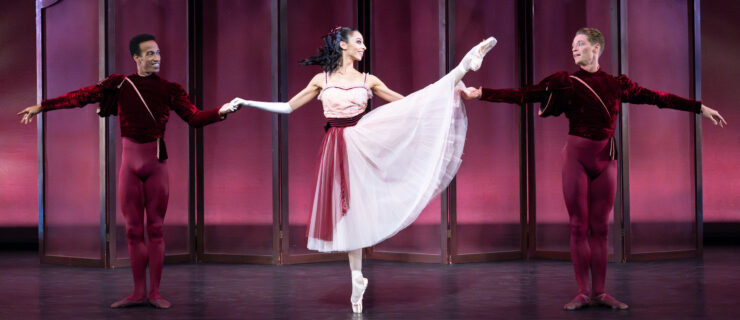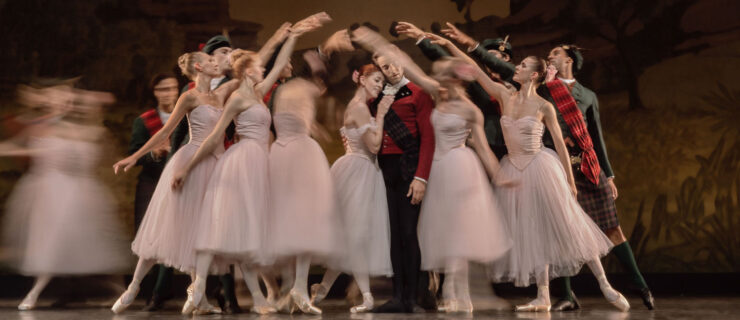New Beginning
On a gorgeous afternoon in late August, Trey McIntyre settled himself on a couch-sized rock in the middle of the Jacob’s Pillow campus in Becket, Massachusetts, stretched out his long, long legs and mused on what it’s like to become a father.
No, the 38-year-old choreographer wasn’t talking about changing diapers and setting the alarm for night feedings. McIntyre’s baby is his new full-time company of 10 dancers, based in Boise, Idaho. The Trey McIntyre Project has been in existence as a summer pickup troupe since 2005, but this, he says, is different.
“The knowledge that we’re doing this for the full year, the weight of this responsibility, feels like parenting,” says McIntyre. The new company, fresh from a three-week residency at the White Oak Plantation in Yulee, Florida, had made its debut at the Pillow just a few days before, presenting two world premières: McIntyre’s Leatherwing Bat, set to music by Peter, Paul and Mary, and the pas de deux Surrender.
Jacob’s Pillow Executive Director Ella Baff has championed TMP since its first summer. “Trey has developed an extensive vocabulary that takes highly trained classical dancers into a very contemporary point of view,” she says. “There’s a freshness about his work—it’s sophisticated but kind of innocent at the same time. He’s interested not only in abstract movement but also in character development and staging psychological material. He can manage by turns humor, empathy, darkness and light.”
McIntyre says his decision to take TMP full- time was largely based on a desire to “go deeper” with a group of dancers he knows intimately—“people I can trust, with whom I can go to a scarier place in myself.” With a full-time group that spends intensive time together year-round, the trust level among company members can grow more quickly than it does in a summer pickup troupe, he says. It’s an environment in which McIntyre can relax into a creative process that’s very much informed by his personal and artistic connection to his dancers.
He approaches choreography like a Method actor. “There are certain emotional states I’ve wanted to conjure up in a piece that I’ve stayed with on my own and brought to the studio,“ he says. According to company member Virginia Pilgrim, 24, that’s one reason why McIntyre is extremely demanding as a choreographer—“but in a great way that makes you feel he’s pulling the best out of you,” she says. “I love how hard we work and how fulfilling it is when all’s said and done. It’s not even about the finished product, but each day I go home thinking ‘Wow, we really accomplished something today.’ He’s built the company with an atmosphere for all of us to thrive in, to feel a freedom to do what we do without any reservations or fears, and to know we’re doing something important.”
McIntyre seems drawn to ever-deepening levels of discovery. “I’m committed to examining, especially institutionally and structurally, the why of the way we do the things we do,” he says. To that end, he has assembled a production staff whose strong suit is enthusiasm and out-of-the-box thinking rather than training or experience. Chief among them is John Michael Schert, a 27-year-old dancer with the company who is also its executive director. Schert has no business or management background but has observed the inner workings of dance companies as a member of Alonzo King’s LINES Ballet, Lar Lubovitch Dance Company and American Ballet Theatre.
“The driving force behind the business of a dance company has to be, first and foremost, always the art,” says Schert. “We’re doing the art of Trey McIntyre but we’re also doing the art of ourselves—we’re working on becoming fuller artists, fuller people. Trey creates the environment for everyone who works in it to become their best selves.” McIntyre sees every member of the company—from dancers to administrative staff—as artists of a sort, doing their best to make this project fly. The company operates not so much as a collective, but rather as an informed consensus with McIntyre and Schert making final decisions. As the latter puts it, “There are clear lines of communication and authority but the entire company spends a lot of time illuminating the ethic of the company.”
The company’s mission—to honor not only McIntyre’s vision but also the personal and artistic journey of each dancer (while still making smart business choices)—drives every decision TMP makes, starting with the surprising choice of Boise as its home base. The summer troupe discovered Boise and returned to it often between performances in Vail and Aspen and late-summer engagements at the Pillow.
“It was always one of our favorite stops,” says Schert. “We felt an immediate sense of belonging.” When it came time to put down roots, “Boise won for the possibilities and potential that exist here,” he says. The Idaho capital, population 211,000, has a vigorous, youthful energy that parallels the company’s sensibility. “Being here is conducive to the community we seek to create with TMP: process versus product, growth versus attainment,” he continues. The city has embraced the company, almost immediately offering TMP several options for its home.
“One of the reasons we moved to Boise was the pervasive feeling of welcome there,” Schert says, adding that the company’s opening performance was “like a rock concert. The cheers when the lights went down pre-show were almost overwhelming.” TMP’s relationship with Ballet Idaho (also based in Boise) is a companionable one, Schert maintains. BI presented McIntyre’s summer touring company in 2007 and the two companies share studio space and guest teachers and work collaboratively to develop Boise’s arts culture and audiences.
Business-wise, Schert sees geography as irrelevant. Building on the appeal and audience support base McIntyre accumulated during his years as resident choreographer for Oregon Ballet Theatre, Ballet Memphis and The Washington Ballet, the company relies on a dedicated core of supporters in Portland, Memphis and Washington, DC, who form the company’s national board and its regional Resource Councils in Houston, Milwaukee and Boise. These local support groups host events and fundraisers, bringing new contributors into the fold; donors are invited to sponsor a TMP dancer with a gift that provides half of his or her salary during the year.
The company also raises its visibility with an online presence that includes pages on Facebook and MySpace; video clips on dancemedia.com and YouTube; and free podcasts featuring the company—taped and created by McIntyre—available on iTunes and at TMP’s interactive website (www.treymcintyre.com).
“They’ve engineered a very, very successful approach to staying streamlined and focused,” says Baff. “I really appreciate how energetic the whole enterprise is—that kind of energy builds a great base of support that hopefully will be able to sustain them over the years.”
The company’s $1.5 million operating budget, which allows TMP to pay its dancers competitive salaries and provide full dental and medical benefits, is met nearly equally by donations and earned income. TMP kicked off its inaugural year with a September performance at the 2,000-seat Morrison Center for the Performing Arts on the campus of Boise State University; the company also plans to perform at the university’s smaller Special Events Center while exploring several options for a permanent home.
For most of the year, however, TMP will be on the road: A 30-city 2008–09 tour, capitalizing on the popularity built by its summer tours, includes visits to the Dominican Republic and the Spring Festival in Gyor, Hungary. McIntyre and his dancers will also find time to work on a new piece, A Day in the Life, set to songs by the Beatles, scheduled to premiere in Boise in February. And they’ll travel to Montana’s Glacier National Park to film footage for a multimedia dance work commissioned by Wolf Trap Foundation for the Performing Arts and the National Park Service.
McIntyre has made more than 75 works for companies around the world, garnering a reputation for choreography that takes ballet in unexpected directions, both artistically and emotionally. His artistry springs from his quest for authenticity and integrity: “Being true to every single moment and holding myself to the criteria of ‘Am I speaking the truth, am I revealing myself?’”
As Pilgrim says, “Every time we approach a ballet, he wants us to approach it differently than we did before. He believes you’re a new person each day with new experiences behind you. We’re not striving for perfection, we’re striving for growth.”
Tresca Weinstein is a freelance writer who covers dance, the visual arts, yoga, travel and home design for national and regional publications.





